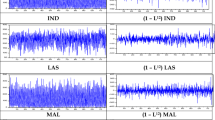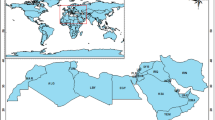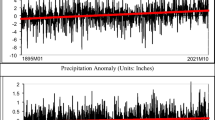Abstract
In this paper, we examine the statistical properties of rainfall data and temperature in six sub-Saharan African countries in the western, eastern, and southern regions (Botswana, Ethiopia, Ghana, Nigeria, Uganda, and South Africa) using time series data spanning between 1900 and 2012. By using linear trends, seasonality, and long-range dependence models, in fractional or I(d) frameworks, the results first indicate that time trends are required in most cases to explain the time series properties of the climatic series. Evidence of anti-persistence (d < 0) or I(0) behavior is found for the rainfall data, while long memory (d > 0) is found for the temperature data. Evidence of structural breaks are only found in the cases of Ethiopia, Ghana, and Uganda for the temperature data. With both series displaying significant evidence of seasonality and by working with the seasonally differenced data, the results show evidence of I(0) behavior or anti-persistence (d < 0) for the rainfall data but long memory (d > 0) for the temperature data. Testing the causality between the two variables, the results indicate evidence of causality in the two directions in all cases except for the case of the temperature on the rainfall in South Africa. The implication of the results obtained here is that erratic or constant rainfall is expected in Africa in the future while temperature is likely to continue to increase, and these subsequently lead to future warming experiences.



Similar content being viewed by others
Notes
An extension of this to monthly frequency data is found in Beaulieu and Miron (1993).
The seasonal coefficients for the temperatures range between 0.812 (UGD) and 0.986 (BOT and ZAF) (see Table 2).
Using the Dickey et al. (1986) tests, the results were supportive of the seasonal unit roots in practically all cases.
The model of Bloomfield is a non-parametric approach of modeling I(0) processes that produces autocorrelations decaying exponentially as in the AR(MA) case.
Note that with autocorrelated errors, the estimates of d for the temperature are negative but the intervals include the I(0) hypothesis in the majority of the cases.
References
Abadir KM, Distaso W, Giraitis L (2007) Nonstationarity-extended local Whittle estimation. J Econ 141:1353–1384
Adenstedt RK (1974) On large sample estimation for the mean of a stationary random sequence. Ann Stat 2:259–272
Bai J, Perron P (2003) Computation and analysis of multiple structural change models. J Appl Econ 18:1–22
Beaulieu JJ, Miron JA (1993) Seasonal unit roots in aggregate US data. J Econ 55:305–328
Bloomfield P (1973) An exponential model in the spectrum of a scalar time series. Biometrika 60:217–226
Bloomfield P, Nychka D (1992) Climate spectra and detecting climate change. Clim Chang 21:275–287
Boko M, Niang I, Nyong A, Vogel C, Githeko A, Medany M, Osman-Elasha B, Tabo R, Yanda P (2007) Africa. In: Parry ML, Canziani OF, Palutikof JP, van der Linden PJ, Hanson CE (eds) Climate change 2007: impacts, adaptation and vulnerability. Contribution of Working Group II to the Fourth Assessment Report of the Intergovernmental Panel on Climate Change. Cambridge University Press, Cambridge, pp 433–467 https://www.ipcc.ch/pdf/assessment-report/ar4/wg2/ar4-wg2-chapter9.pdf. Accessed 20 June2016
Bounoua L, Collatz GJ, Los SO, Sellers PJ, Dazlich DA, Tucker CJ, Randall DA (2000) Sensitivity of climate to changes in NDVI. J Clim 13:2277–2292
Box GEP, Jenkins GM, Reinsel GC (2008) Time series analysis: forecasting and control, 4th edn. Wiley, Hoboken
Caporale GM, Cunado J, Gil-Alana LA (2012) Deterministic versus stochastic seasonal fractional integration and structural breaks. Stat Comput 22(2):349–358
Chappell A, Agnew CT (2004) Modelling climate change in West African Sahel rainfall (1931-90) as an artifact of changing station locations. Int J Climatol 24:547–554
Christensen JH, Hewitson B, Busuioc A, Chen A, Gao X, Held I, Jones R, Koli RK, Kwon W-T, Laprise R, Rueda VM, Mearns L, Menéndez CG, Räisänen J, Rinke A, Sarr A, Whetton P (2007) Regional climate projections. In: Qin D, Manning M, Chen Z, Marquis M, Averyt KB, Tignor M, Miller HL (eds) Climate change 2007: the physical science basis. Contribution of Working Group I to the Fourth Assessment Report of the Intergovernmental Panel on Climate Change, S. Solomon. Cambridge University Press, Cambridge, pp 847–940
Climate and Development Knowledge Network (CDKN) (2014) The IPCC’s Fifth Assessment Report What’s in it for Africa? http://cdkn.org/wp-content/uploads/2014/04/AR5_IPCC_Whats_in_it_for_Africa.pdf. Accessed 20 June 2016
Conway D, Mould C, Bewket W (2004) Over one century of rainfall and temperature observations in Addis Ababa, Ethiopia. Int J Climatol 24:77–91
Cunado J, Gil-Alana LA, Gupta R (2016) Persistence, mean reversion and nonlinearities in CO2 emissions. Evidence from the BRICS and G7 countries. Environ Resour Econ 67(4):869–883
Dahlhaus R (1989) Efficient parameter estimation for self-similar process. Ann Stat 17(4):1749–1766
Dai A, Lamb PJ, Trenberth KE, Hulme M, Jones PD, Xie P (2004) The recent Sahel drought is real. Int J Climatol 24:1323–1331
Dickey DA, Hasza DP, Fuller WA (1986) Testing for unit roots in seasonal time series. J Am Stat Assoc 79:355–367
Diebold FX, Inoue A (2001) Long memory and regime switching. J Econ 105:131–159
Epstein PR, Mills E (eds) (2005) Climate change futures: health, ecological and economic dimensions. Center for Health and the Global Environment, Harvard Medical School, Boston 142 pp
Franses PH, Hobijn B (1997) Numbers from all the tables in critical values for unit root tests in seasonal time series. J Appl Stat 24:25–46
Gil-Alana LA (2003) An application of fractional integration to a long temperature time series. Int J Climatol 23:1699–1710
Gil-Alana LA (2005) Statistical model for the temperatures in the Northern hemisphere using fractional integration techniques. J Clim 18(24):5537–5369
Gil-Alana LA (2006) Testing seasonality in the context of fractionally integrated processes. Annales D’économie Et De Statistique 81:61–79
Gil-Alana LA (2008a) Time trends with breaks and fractional integration in temperature time series. Clim Chang 9:325–337
Gil-Alana LA (2008b) Fractional integration and structural breaks at unknown periods of time. J Time Ser Anal 29:163–185
Gil-Alana LA (2012) Long memory, seasonality and time trends in the average monthly temperatures in Alaska. Theor Appl Climatol 108:385–396
Gil-Alana LA, Robinson PM (1997) Testing of unit roots and other nonstationary hypotheses in macroeconomic time series. J Econ 80:241–268
Gil-Alana LA, Robinson PM (2001) Testing of seasonal fractional integration in UK and Japanese consumption. J Appl Econ 16:95–114
Gil-Alana LA, Singh P (2015) The impact of ethnic violence in Kenya on wheat and maize markets. J Afr Econ 24(4):502–529
Granger CWJ (1980) Long memory relationships and the aggregation of dynamic models. J Econ 14(2):227–238
Granger CWJ (1981) Some properties of time series data and their use in econometric model specification. J Econ 16:121–131
Granger CWJ, Hyung N (2004) Occasional structural breaks and long memory with an application to the S&P 500 absolute stock return. J Empir Financ 11:399–421
Granger CWJ, Joyeux R (1980) An introduction to long-memory time series models and fractional differencing. J Time Ser Anal 1:15–29
Grenander U, Rosenblatt M (1957) Statistical analysis of stationary time series. Chelsea Publishing Company, New York
Hamilton JD (1994) Time series analysis. Princeton University Press, Princeton 820 pages
Hansen J, Lebedeff S (1987) Global trends of measured surface air temperature. J Geophys Res 92:345–372
Hansen J, Lebedeff S (1988) Global surface air temperatures. Update through 1987. Geophys Res Lett 15:323–326
Hosking JRM (1981) Fractional differencing. Biometrika 68:165–176
Hudson DA, Jones RG (2002) Regional climate model simulations of present day and future climates of Southern Africa. Technical Note 39. Hadley Centre, Bracknell 42 pp
Hulme M, Doherty R, Ngara T, New M (2005) Global warming and African climate change. In: Low PS (ed) Climate Change and Africa. Cambridge University Press, Cambridge, pp 29–40
Hurst H (1951) The long-term storage capacity of reservoirs. Trans Am Soc Civ Eng 116:770–799
Hylleberg S, Engle RF, Granger CWJ, Yoo BS (1990) Seasonal integration and cointegration. J Econ 44:215–238
IPCC (2001) Intergovernmental Panel on Climate change. Third assessment report: climate change 2001. WG1: The scientific basis, summary for policymakers, Q2:4-5, pp 4-6 Geneva, Switzerland
IPCC (2007a) Intergovernmental Panel on Climate change. Fourth Assessment Report: Climate change 2007. Summary for policy makers: understanding and attributing climate change. Cambridge University Press, Cambridge, pp 10–13
IPCC (2007b) Intergovernmental Panel on Climate change. Fourth assessment report: climate change 2007: chapter 11—regional climate projections. Cambridge University Press, Cambridge, pp 899–904
IPCC (2014). Fifth assessment report: climate change 2014: impacts, adaptation, and vulnerability. Chapter 22, Africa, pp 1201–1236, Geneva, Switzerland
Jenkins GS, Adamou G, Fongang S (2002) The challenges of modelling climate variability and change in West Africa. Clim Chang 52:263–286
Johansen S (2008) A representation theory for a class of vector autoregressive models for fractional models. Econom Theory 24:651–676
Kruger AC, Shongwe S (2004) Temperature trends in South Africa: 1960–2003. Int J Climatol 24:1929–1945
Lo AW (1991) Long-term memory in stock market prices. Econometrica 59(5):1279–1313
MacKinnon JG, Haug AA, Michelis L (1999) Numerical distribution functions of likelihood ratio tests for cointegration. J Appl Econ 14:563–577
Malhi Y, Wright J (2004) Spatial patterns and recent trends in the climate of tropical rainforest regions. Philos Trans R Soc Lond B Biol Sci 359:311–329
McMichael AJ, Woodruff RE, Hales S (2006) Climate change and human health: present and future risks. Lancet 367:859–869
Montanari A, Rosso R, Taqqu MS (1996) Some long-run properties of rainfall records in Italy. J Geophys Res 101:431–438
Moreno M (2000) Riding the temp. Weather Derivatives, FOW Special Supplement
New M, Hewitson B, Stephenson DB, Tsiga A, Kruger A, Manhique A, Gomez B, Coelho CAS et al (2006) Evidence of trends in daily climate extremes over southern and west Africa. J Geophys Res–Atmos 111:D14102. https://doi.org/10.1029/2005JD006289
Niang I, Ruppel OC, Abdrabo MA, Essel A, Lennard C, Padgham J, Urquhart P (2014) Africa. In: Barros VR, Field CB, Dokken DJ, Mastrandrea MD, Mach KJ, Bilir TE, Chatterjee M, Ebi KL, Estrada YO, Genova RC, Girma B, Kissel ES, Levy AN, MacCracken S, Mastrandrea PR, White LL (eds) Climate change 2014: impacts, adaptation, and vulnerability. Part B: regional aspects. Contribution of Working Group II to the Fifth Assessment Report of the Intergovernmental Panel on Climate Change. Cambridge University Press, Cambridge, pp 1199–1265 http://ipcc-wg2.gov/AR5/images/uploads/WGIIAR5-Chap22_FINAL.pdf. Accessd 20 June 2016
Nicholls N, Gruza GV, Jouzel J, Karl TR, Ogallo LA, Parker DE (1996) Observed climate variability and change. In: Houghton JT, Meiro Filho LG, Callendar BA, Kattenburg A, Maskell K (eds) Climate change 1995: the science of climate change. Cambridge University Press, Cambridge, pp 133–192
Nicholson SE, Selato JC (2000) The influence of La Nina on African rainfall. Int J Climatol 20:1761–1776
Ohanissian A, Russell JR, Tsay RS (2008) True or spurious long memory? A new test. J Bus Econ Stat 26(2):161–175
Park RE, Mitchell BM (1980) Estimating the autocorrelated error model with trended data. J Econ 13:185–201
Pascual M, Ahumada JA, Chaves LF, Rodó X, Bouma M (2006) Malaria resurgence in the East African highlands: temperature trends revisited. Proc Natl Acad Sci U S A 103:5829–5834
Patz JA, Olson SH (2006) Climate change and health: global to local influences on disease risk. Ann Trop Med Parasitol 100:535–549
Percival D, Overland J, Mofjeld H (2001) Interpretation of North Pacific variability as a short and long memory process. Tech Rep Series NRCSE 065:35
Phillips PCB, Shimotsu K (2004) Local Whittle estimation in nonstationary and unit root cases. Ann Stat 32:656–692
Phillips PCB, Shimotsu K (2005) Exact local Whittle estimation of fractional integration. Ann Stat 33:1890–1933
Prais SJ, Winsten CB (1954) Trend estimators and serial correlation, Cowles Commission Monograph, No. 23. Yale University Press, New Haven
Robinson PM (1978) Statistical inference for a random coefficient autoregressive model. Scand J Stat 5:163–168
Robinson PM (1994) Efficient tests of nonstationary hypotheses. J Am Stat Assoc 89:1420–1437
Robinson PM (1995) Gaussian semiparametric estimation of long range dependence. Ann Stat 23:1630–1661
Stephenson DB, Pavan V, Bojariu R (2000) Is the North Atlantic oscillation a random walk? Int J Climatol 20:1–18
Swart R, Mitchell J, Morita T, Raper S (2002) Stabilisation scenarios for climate impacts assessment. Glob Environ Chang 12:155–165
van Lieshout M, Kovats RS, Livermore MTJ, Martens P (2004) Climate change and malaria: analysis of the SRES climate and socio-economic scenarios. Glob Environ Chang 14:87–99
Velasco C (1999) Gaussian semiparametric estimation of nonstationary time series. J Time Ser Anal 20:87–127
Wakaura M, Ogata Y (2007) A time series analysis on the seasonality of air temperature anomalies. Meteorol Appl 14:425–434
Woodward WA, Gray HL (1993) Global warming and the problem of testing for trend in time series data. J Clim 6:953–962
Yaya OS, Fashae OA (2015) Seasonal fractional integrated time series models for rainfall data in Nigeria. Theor Appl Climatol 120:99–108
Acknowledgements
The authors gratefully acknowledge the comments of the Editor and two anonymous reviewers.
Author information
Authors and Affiliations
Corresponding author
Rights and permissions
About this article
Cite this article
Gil-Alana, L.A., Yaya, O.S. & Fagbamigbe, A.F. Time series analysis of quarterly rainfall and temperature (1900–2012) in sub-Saharan African countries. Theor Appl Climatol 137, 61–76 (2019). https://doi.org/10.1007/s00704-018-2583-5
Received:
Accepted:
Published:
Issue Date:
DOI: https://doi.org/10.1007/s00704-018-2583-5




